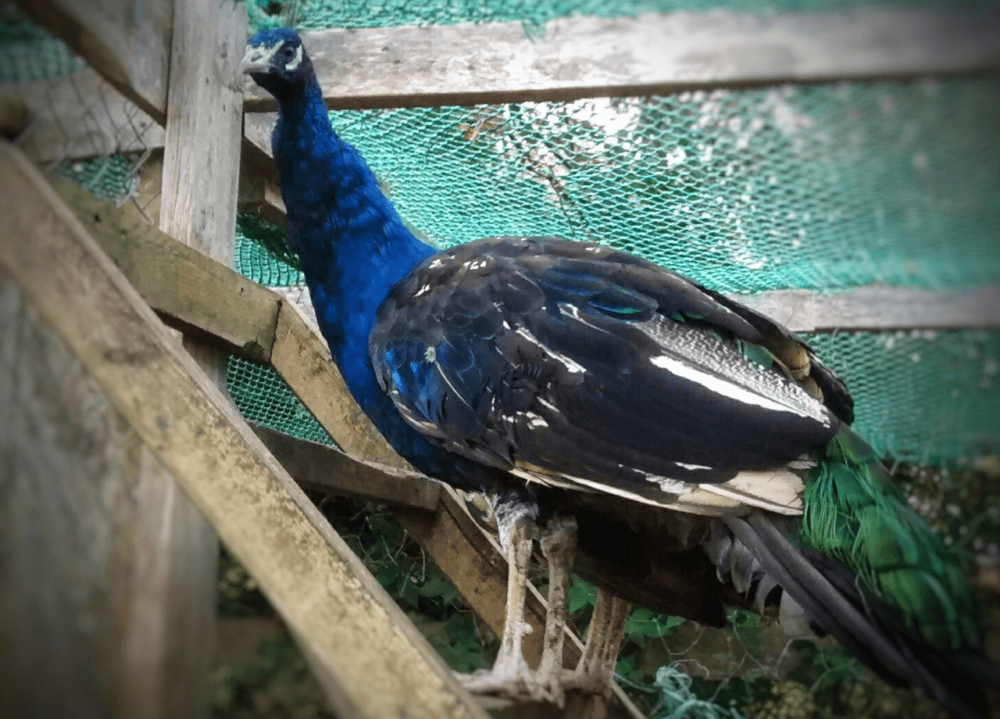Both peacocks and peahens are spectacularly dazzling and vibrant birds. Many people, though, question their usefulness on a homestead.
- Peafowl At a Glance
- 10 Benefits of Raising Peafowl
- 1. Peafowl Are Extraordinarily Beautiful
- 2. Peafowl Are Profitable to Breed
- 3. Peafowl Enhance Petting Zoos
- 4. Peafowl Benefit Agritourism
- 5. Showing Peafowl
- 6. Peafowl Feathers Are Great for Crafting
- 7. They Have a Long Lifespan
- 8. Alert to Predators
- 9. Peahen Eggs Are Valuable
- 10. Peafowl Are Inquisitive and Form Bonds
- 1. Peafowl Are Extraordinarily Beautiful
- Why You Shouldn’t Raise Peafowl
- Basic Care Needs of Peafowl
- Are Peafowl Good for Beginners?
- Peafowl: Pros and Cons
- Peacock FAQs
- Conclusion
Many traditional homesteaders don’t consider peafowl a critical animal for the farm. That’s because they don’t support self-sufficiency as much as chickens or ducks do. Peahens don’t lay many eggs, and peafowl usually isn’t raised for meat.
So, why raise peafowl on your farm? Peafowls have many uses, such as breeding and feathers for crafting. They are loved in petting zoos, excel in shows, and more. In addition, they’re rewarding and fascinating birds to raise and keep!
That said, there are a few things that make peafowl unsuitable. For example, they’re extremely loud, often impractical, require a lot of space, and don’t do well in damp weather. Peafowl also aren’t good companions.
All birds have unique advantages and challenges, but peafowl offer benefits that chickens and ducks don’t. Keep reading to find out!
Peafowl At a Glance
| Origin: Asia |
| Lifespan: 15-40 years |
| Conservation Status: India Blue peafowl – Least Concern. Java Green – Endangered. Congo Peafowl – Vulnerable. |
| Weight: 6-13 lbs |
| Types: India Blue, Java Green, and Congo |
| Common India Blue Variations: Black-Shouldered, Pied, Leucistic (white), Silver, Opal, Peach |
| Egg Count: 12-24 eggs per year |
| Breeding Season: February-August |
| Care Difficulty: Medium to high |
| Diet: Protein-based; a game bird or turkey feed, insects, plant matter, supplemental sunflower seeds, cooked meat |
| Temperament: Inquisitive, intelligent, and alert, but standoffish and nervous around humans |
| Friendliness Level: Low to medium |
| Family-Friendly: Low to medium |
| Cost: $30-$100 per chick, $50-$400+ per adult |
10 Benefits of Raising Peafowl
Peafowl are rewarding to keep and raise, even if they don’t have a conventional purpose. They’re unique and fascinating birds and a joy to have. You should raise peafowl ultimately because you’re passionate about them.
Someone recently remarked that peafowl are useless on a farm, especially when compared to other small animals. While they may be right in a traditional sense, peafowl offer many advantages. Peafowl can have several uses if you get a bit creative. Here are nine benefits of raising peafowl.

1. Peafowl Are Extraordinarily Beautiful
Beauty is an advantage to raising peafowl, which appeals to many people. Peafowl enrich your surroundings, but remember that they’re not “lawn ornaments.” You should view them as a pet.
Both peacocks and peahens are extremely attractive birds. Peacocks are almost overwhelmingly dramatic, especially when their vivid iridescent feathers turn rose gold or purple in the sunlight.
India Blue peahens have striking emerald green necks and an elegant appearance, despite their unfair reputation for being drab. There are many variations of peafowl with extraordinarily lovely peahens, too.
Akila is one of the prettiest peafowl I’ve seen. I love the way her green-flecked neck contrasts with the rest of her feathers. Many people are captivated by leucistic and violet peafowl. Almost every variation is beautiful in its own right.
2. Peafowl Are Profitable to Breed
If you enjoy preserving and improving generations of peafowl, you may also consider breeding.
Breeding peafowl has rewards all of its own. First, they’re fascinating birds. It’s an incredible experience to watch peachicks mature and find suitable homes after that.
You can also make a decent profit from them. One peachick can sell for over $50. If six in a clutch sell for that amount, you’ve pocketed $300. You can make more from rare variations but also need a niche market.
Peafowl are challenging to breed, though. They have relatively low hatch rates and additional low survival rates. Peachicks are incredibly delicate, fragile creatures that easily succumb to illness or death. You’ll need to take extra care with them.
Peahens are quite maternal, and they’ll raise their own young. Azule, our oldest peahen, set her clutch for the first time last year. We take the eggs, and our silkies or Australorp hens set and raise them. But this time, Azule was broody and determined to hatch her own.
In approximately twenty-eight days, two out of nine eggs hatched. This is unusual for us. Most years, we set six to nine eggs at a time, and between three and five hatch. This time, only one peachick survived.
Azule is surprisingly dedicated and attentive to her young peacock. They have such an incredible strong bond, even after six months!
I’m excited to see Atlas and Akila’s peachicks this coming season. As black-shouldered peafowl, their peachicks will hatch a creamy color.
You’ll need a market for your peafowl before you start breeding. Make sure there isn’t too much competition in your area that you can’t fit in.
3. Peafowl Enhance Petting Zoos
Do you have a petting zoo to supplement your income? Peafowl give this kind of operation a novelty factor and are excellent in your marketing strategy. They always draw in more traffic and dazzle crowds. Moreover, petting zoos offer a unique opportunity to educate the public about peafowl!
Set up a website and social media profile, and include pictures of your peafowl. You’ll likely reach people you otherwise wouldn’t because they’re interested in seeing a more exotic bird!
4. Peafowl Benefit Agritourism
Agritourism is more involved than a petting zoo. These types of farms are rising in popularity and unlock another source of income for farmers and homesteaders.
Agritourism typically targets city or town folk who are curious about farms and want to experience a taste of that lifestyle. Unlike petting zoos, agritourism usually offers specific activities for visitors. The point is to simulate farm life for people without experience it.
You can open your farm to the public on particular days and charge admission. Visitors can learn about farming and even assist with chores. Yes, people will pay you to clean your coops and fields!
So how do peafowl fit in? Peafowl can enrich the overall experience of agritourism because they’re unusual and exotic. Most people don’t often have the opportunity to see peafowl up close. Agritourism gives them that chance.
Make sure you have boundaries in place, such as set hours, prices, packages, and even literal boundaries. You should also work out legal liabilities in case there is an injury on the premises.
Your farm may benefit from a gate in the driveway to discourage people from visiting during your closed hours – which they will. You might also consider burning parts of your farm to protect your animals further. There are many benefits to agritourism, but it wasn’t suitable for us at the time.
5. Showing Peafowl
Peafowl naturally excel in the world of bird shows. Some shows offer cash prizes, and champion birds – or their offspring – often sell for premium prices.
Take care not to stress out your birds. Constant shows can create a strain that affects their health. Even though India Blue peafowls tend to be hardy and adaptable, they can easily get overwhelmed.
6. Peafowl Feathers Are Great for Crafting
You can use your peacock’s vibrant train feathers in crafting! They’re also used sometimes for fly fishing.
There are all sorts of ways to repurpose feathers peacocks drop every year. You can sell the feathers or the crafts you make with them at your farmer’s markets or on Etsy or incorporate them into your home.
The long train feathers are also excellent gifts for your friends and family. Plus, your cat will love playing with them in the house!
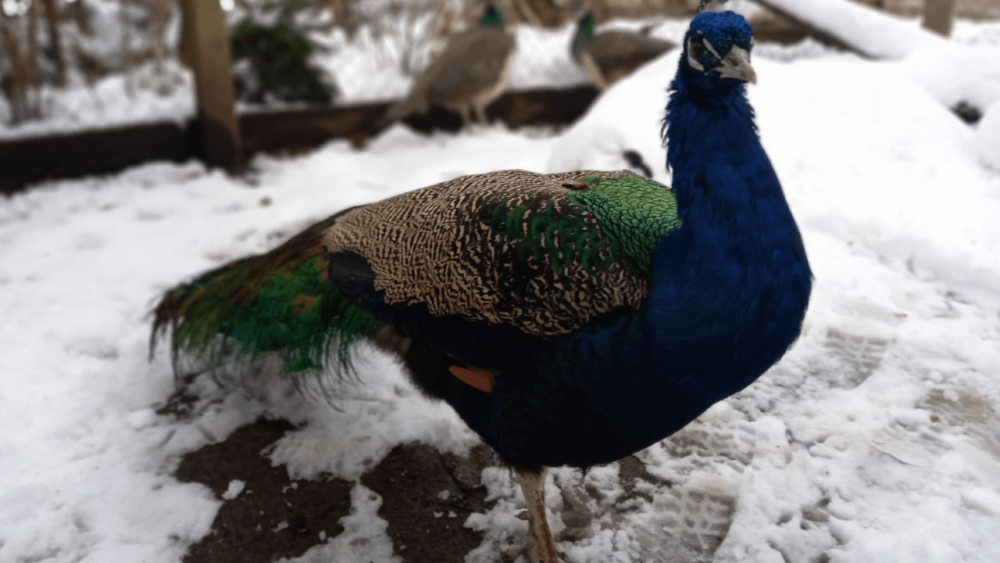
7. They Have a Long Lifespan
Peafowl live fifteen to forty years! This is certainly an advantage if you’re considering raising these remarkable birds. Unlike other birds with short lifespans, you’ll be able to spend many years enjoying your peafowl and bonding with them.
This is one reason why you should think carefully about getting peafowl. You’ll have them for a long time! Can you realistically care for them for years – or even decades?
In the wild, peafowl also can live 15-25 years, but their lives are often cut short by hunting, predators, illnesses, and other issues. Peafowl in captivity generally live much healthier lives.
8. Alert to Predators
Peafowl are extremely alert to predators. If they see a hawk overhead or a fox trotting by, they sound the alarm to warn the others.
Pay attention to your peafowl’s sounds, and always check if they sound distressed! Peafowl have acute hearing and are rarely wrong about predators, unlike other melodramatic birds like chickens and guineafowl.
That said, peafowl do NOT protect chickens from predators! Peafowl also won’t guard your property. This is a harmful myth that arose primarily because peafowl are very vigilant to the presence of predators. They warn when a predator is nearby but don’t chase predators away.
Peafowl are susceptible to being killed by predators themselves. Their instinct is to warn others and flee as quickly as possible, not attack.
9. Peahen Eggs Are Valuable
Peahen eggs are more expensive because they only lay small clutches. This may also create a demand for them in your area.
For example, I know a woman who drains eggs, paints them, and sells them. She’s willing to pay extra for peahen eggs for her crafts.
Some people prefer incubating and hatching eggs rather than buying peachicks or adults. You may not want to deal with the hassle of peachicks, but selling hatching eggs might be a lucrative side business!
10. Peafowl Are Inquisitive and Form Bonds
Peafowl are extremely intelligent and curious, with diverse, fascinating personalities. They’ll follow you around their coop just to see what you’re doing!
You need to earn their trust gradually. Peafowl hate being handled, and they prefer having the choice to come to you or not. I like their more independent nature, but not everyone does.
Eventually, you can even develop a strong bond with peafowl. They’re loyal once bonded, and while they won’t become cuddly companions overnight, they demonstrate affection and trust in other ways. For example, they might perch on your arm and eat from your hand.
Spend time daily with your peafowl, so they grow accustomed to your presence. As they become more curious and less flighty, try crouching with a bit of food in your hand and wait for them to approach.
Don’t force your peafowl to like you; always give them the option to approach you or keep their distance.
Why You Shouldn’t Raise Peafowl
Raising peafowl comes with a few disadvantages and inconveniences. Be realistic and keep a balanced view!
Let’s dive into the three most common issues with raising peafowl.
Peafowl are Noisy
Peafowl disrupt the peace of a quiet neighborhood. Don’t get peafowl if you or your neighbors are intolerant of noise. Both peacocks and peahens can be heard from miles away.
Are peahens quiet? It’s a myth that peahens are quieter in volume than peacocks. At times, they can be even louder! Peahens make a “honking” noise that sounds like a cross between a goose and a donkey. In contrast, peacocks are higher-pitched and scream all day and through the night, too.
For the most part, peafowl are the noisiest during the breeding season. They’re typically quiet for the rest of the year unless a predator is nearby or they’re otherwise in distress.
You need to be prepared for the noise if you want to raise peafowl. I take pleasure in hearing the sounds of my peafowl throughout the day, so it doesn’t bother me. Fortunately, our neighbors enjoy it, too!
Peafowl Struggle in Wet, Cold Conditions
Many people are surprised by how hardy peafowl are. They can withstand cold winters as long as their coop is warm and dry. However, peafowl don’t do well in damp, windy, or extremely cold conditions.
Is your area prone to consistent and heavy rainfalls, frigid temperatures, and high levels of wind? If so, then you probably shouldn’t have peafowl. It may be manageable if you provide a dry, ventilated space for them, but you need to consider their needs realistically.
Placing their enclosure on an elevated part of your property will also help increase water drainage and prevent muck.
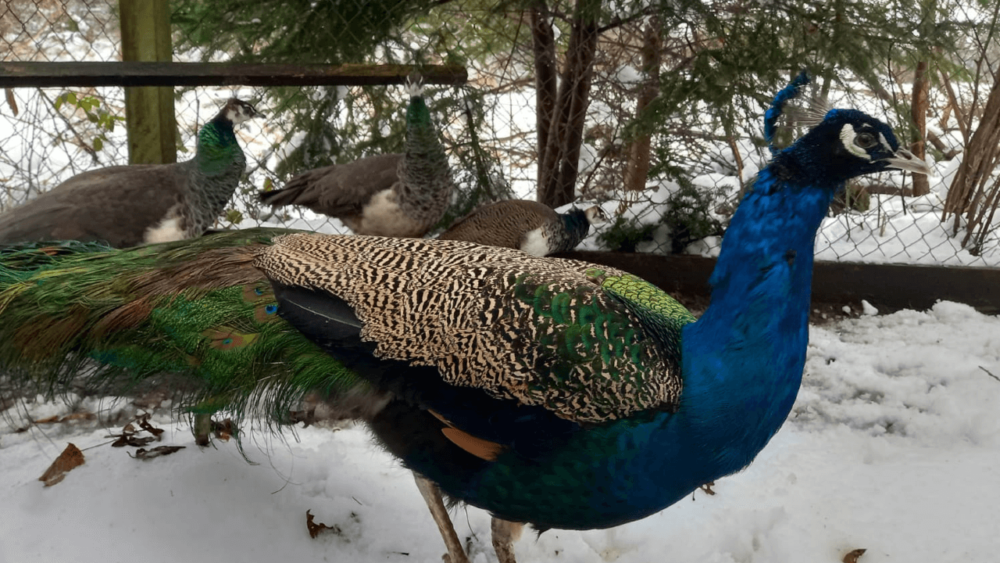
Peafowl Aren’t Traditional Farm Animals
Peafowl aren’t considered practical and ideal birds for a traditional, self-sufficient homestead. Why?
Peafowl generally aren’t raised for meat in North America, although there is a market in some Asian and European countries. They’re so expensive that economically, it makes no sense to raise your own for that purpose – or even purchase the meat.
They aren’t raised for their egg production, either. One peahen lays two or sometimes three clutches per year, each consisting of only six to twelve eggs. Peahen eggs also have a “gamier” taste that some people dislike.
If you value practicality, you may be better off with another type of bird, such as geese, turkeys, or quail.
| Fun Fact: Peacocks were prized on Victorian-era tables. Victorians often cooked them whole, plumage and all. However, they lost favor because of their tough, stringy meat. Some ethnic groups still consider peafowl meat a delicacy, but most people dislike the texture and taste. |
Basic Care Needs of Peafowl
Peafowl have mostly simple needs, but these are crucial to keeping them healthy and robust. Make sure peafowl are legal to own in your local area before you get them!
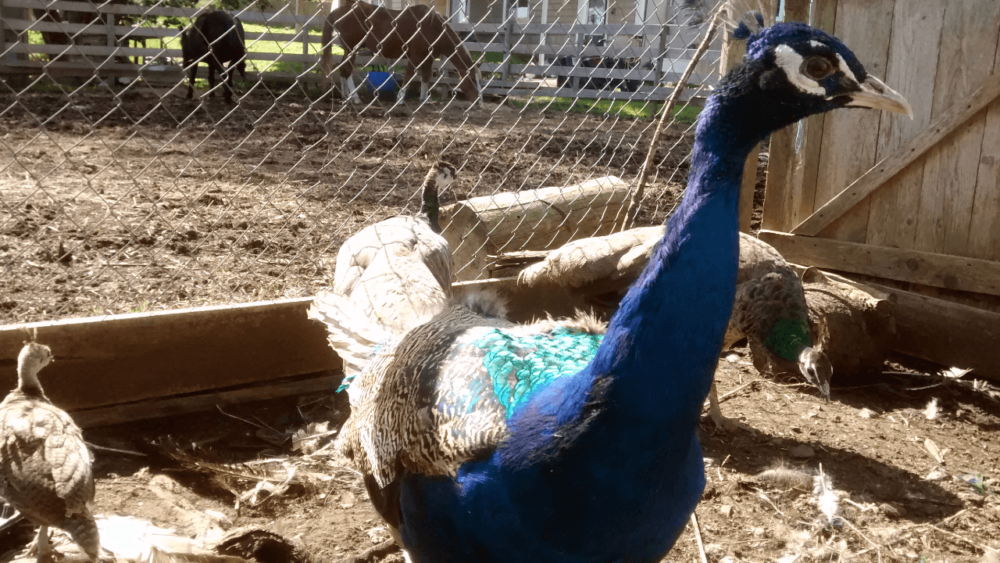
Aztec, Azule, Azora, and Azule’s peachick are all India Blue peafowl
Peafowl Diet
As omnivores, peafowl have a broad diet – but they tend to be picky with what they like!
Peafowl require high protein levels, which you can source in game-bird or turkey feed. Corn, oats, sunflower seeds, and dog food can supplement their diet. They also love eating insects, vegetables, fruit, berries, cooked meat, pasta, rice, worms, and weeds like dandelions, grass, and more.
I use this Peacock feed from Amazon.
Some people raise mealworms for their peafowl. Mealworms are easy to keep and pack a punch in nutrients. You can also feed your peahens finely-crushed eggshells and seafood shells (such as lobster, shrimp, and mussel shells) for an extra boost in calcium.
Overall, peafowl are pretty easy to feed. Avoid chicken or duck food except for the occasional treat. Bread can also cause impaction if you feed too much too often.
Keep clean water for your peafowl at all times to keep them hydrated.
Housing Your Peafowl
All peafowl require an insulated, dry, and secure coop or whether you free-range them. Their enclosure should be free of drafts but provide ventilation. Include a sturdy perch inside that they can rest on at night.
Peafowl usually don’t need heated coops unless you have leucistic or Java Green peafowl, which have specialized care. India Blue peafowl are very cold-hardy, so long as they have sufficient shelter.
Your coop should be taller vertically rather than longer horizontally. Peafowl love perching high; you don’t want your birds trampling your peacock’s train.
Peafowl need 80 square feet of space per bird in their enclosure or aviary. It should also be high enough to accommodate your peacock’s train as he matures! Make sure you provide an aerial covering to prevent them from flying out.
Build perches for them throughout their enclosure, too. They enjoy roosting during the day. Aztec spends much of his time looking out over the marsh and river on a perch. They love being up high! Perches should be at least five feet or so off the ground.

Issues With Free-Ranging Peafowl
The thought of seeing peafowl frolicking in their lawn appeals to many people. There are also advantages to free-ranging your birds. For example, peafowl enjoy foraging for insects and plants, and they’ll help reduce ticks and other pests.
Free-ranging exposes peafowl to predators. They tend to wander into the road, where vehicles hit them. Peacocks and fowl also have a range of five or so miles! They won’t stay on your property, and they’re known to disappear for several days to weeks at a time. Peafowl also cause property damage.
Despite what some people think, having a mate doesn’t discourage peafowl from roaming. Peahens prefer setting their eggs in the woods or another hidden place, making them easy pickings for a fox. Both peacocks and peahens are also simply too curious to stay on your property.
Peacocks are more territorial and may attack passersby, children, or dogs on (or off!) your property.
Don’t clip their wings to prevent flying! Free-ranged peafowl rely on their ability to fly away from predators.
If you live close to your neighbors, it’s best not to free-range your peafowl! They’ll be in your neighbor’s yards, on their porch, vehicles, and houses, becoming a nuisance.
Altogether, it’s better to keep your peafowl penned.
Are Peafowl Good for Beginners?
Peafowl don’t have complex needs but are better suited to more experienced owners. Beginners to the bird world are often disappointed by the standoffish nature of peafowl. They’re also put off when their expectations are wildly unrealistic.
What kind of experience is useful? If you’ve ever raised guineafowl or turkeys, you probably won’t have an issue keeping peafowl. They have essentially the same care needs as turkeys, and their dispositions are similar to guineafowl.
It’s best to start with adult (or young adult) peafowl if you’ve never raised them before. You’ll find it much easier to keep a hardy adult than to raise a more fragile peachick. That said, raising peachicks is doable if you provide the right conditions they need to thrive.
Start with at least three peachicks. Some hatcheries have a set minimum number you can order, especially in the case of shipping. In that case, you can keep the ones you want and sell the others.
Ideally, you should have two peafowls. You can easily keep a peacock and peahen together or two peahens. Peacocks are not voracious breeders like other male birds; they’re happy in pairs.
Don’t keep any more than four or five peahens with your peacock, and never keep two peacocks together, especially during the breeding season. Peacocks will fight each other, often to death.
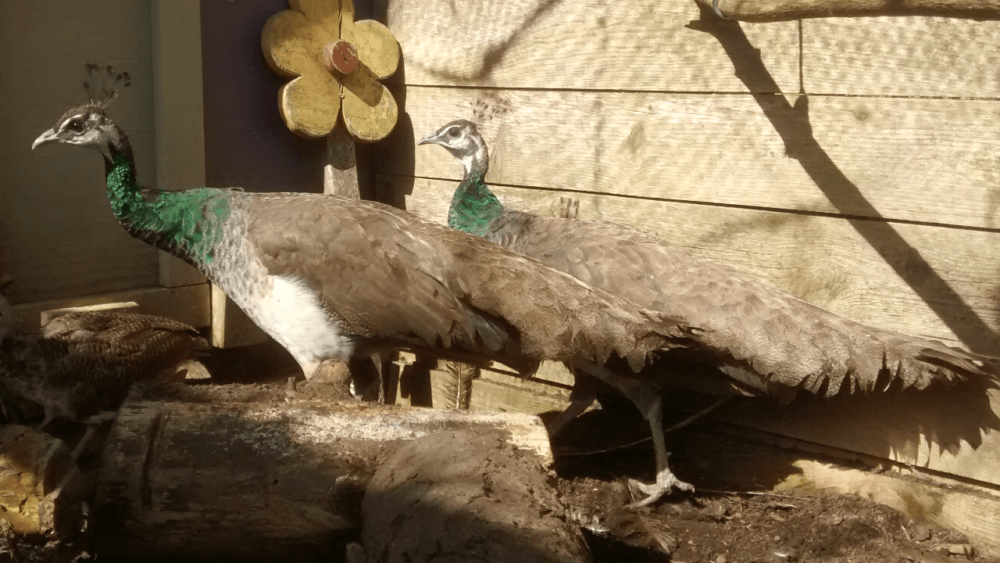
Peafowl: Pros and Cons
| Pros | Cons |
| Dazzling plumage | Expensive |
| Peafowl alert you to the presence of predators | Peachicks are extremely delicate |
| Peafowl excel in petting zoos and agritourism | Difficult to breed |
| Excellent for showing | It can be challenging to find, especially certain variations (also a long waiting list) |
| Great foragers | Peacocks are very territorial during the breeding season |
| Helpful for keeping insect populations low | Free-ranged peafowl become a nuisance, pose safety issues in traffic, wander for miles, and face the threat of predators. |
| Most variations are very cold-hardy (except leucistic peafowl!) | Not very useful on a traditional homestead |
| Profitable for breeding – if you have a market | Peahens lay few eggs per year |
| Feathers from the peacock’s train are great for crafting | Both peacocks and peahens are extremely loud during the breeding season |
| Fun, entertaining, and fascinating to keep | Peafowl may be unsuitable around children |
Peacock FAQs
Why do peacocks spread their tail feathers? Peacocks fan their trains, mistakenly known more often as “tails,” primarily to attract a peahen. It can also be used as a display of dominance and intimidation. It’s a natural behavior that occurs regardless of whether or not you have a peahen with your peacock.
Do peahens spread their tails? Many people don’t realize that peahens also spread their tails, although they’re significantly shorter and less ornate. They do this to intimidate other peahens, birds, or animals, and simply for fun.
What’s the difference between India Blue peacocks (males) and peahens (females)? It’s extremely easy to tell peacocks and peahens apart. Peacocks are much more striking, with blue necks, long trains, and blue crowns. They’re slightly larger than peahens, make a series of high-pitched cries, and tend to be more territorial.
On the other hand, peahens are elegant but more muted than males. They have gray-brown feathers, striking emerald green necks, creamy chests, and green crowns. Peahens are also slightly smaller than peacocks. They make a “honking” sound that resembles a cross between a goose and a donkey.
Is the term “peacock” accurate? Many people call all peafowl “peacocks” without knowing the difference. “Peafowl” is the collective group form that includes males, females, and chicks. The term “peacock” is exclusive only to male peafowl. Female peafowl are accurately called peahens, with peachicks being the babies. These terms are not interchangeable.
Do peafowl bite people? Most peahens do not attack – however, a peacock might bite in the thralls of the breeding season. They generally lunge forward to grab skin between their beaks, but peacocks are also known to attack with long, sharp spurs. They aren’t typically aggressive or territorial during the off-season, though.
Are peafowl friendly? Peafowl are not naturally social. They also hate being handled. They are, however, highly curious creatures and need to know what’s going on at all times. Peacocks, in particular, will probably watch closely and may follow as you clean their coop and do other chores in their enclosure, especially once they are comfortable with you.
Are peafowl good with children? For the most part, they should be fine, especially with peahens. However, peacocks can be aggressive and territorial during the breeding season. Teach your kids to respect their space! Young children usually shouldn’t be around peafowl without supervision for their safety.
Can I tame peafowl? If you spend considerable time handling a peachick, you may be able to tame a peacock and form a lasting bond. When bonded, peafowl follow their chosen human around and may even perch on your arm. But it’s challenging to tame adults, though not impossible. Usually, peafowl “tolerate” humans, and they may eat from your hand at best if they trust you.
Are peafowl good pets? No, peafowl generally do not make good pets in the traditional sense. They’re popular for their impressive plumage, not as companions. Peafowl are closer to being wild than truly “domestic” birds. They’re territorial, standoffish, and they loathe handling. Choose a chicken or duck if you want a pet bird that enjoys snuggles.
Do peafowl have predators? Yes, peafowl have predators. Peafowl face many predators include foxes, dogs, coyotes, and wild cats. However, even a tiny weasel can pose a threat to your peafowl.
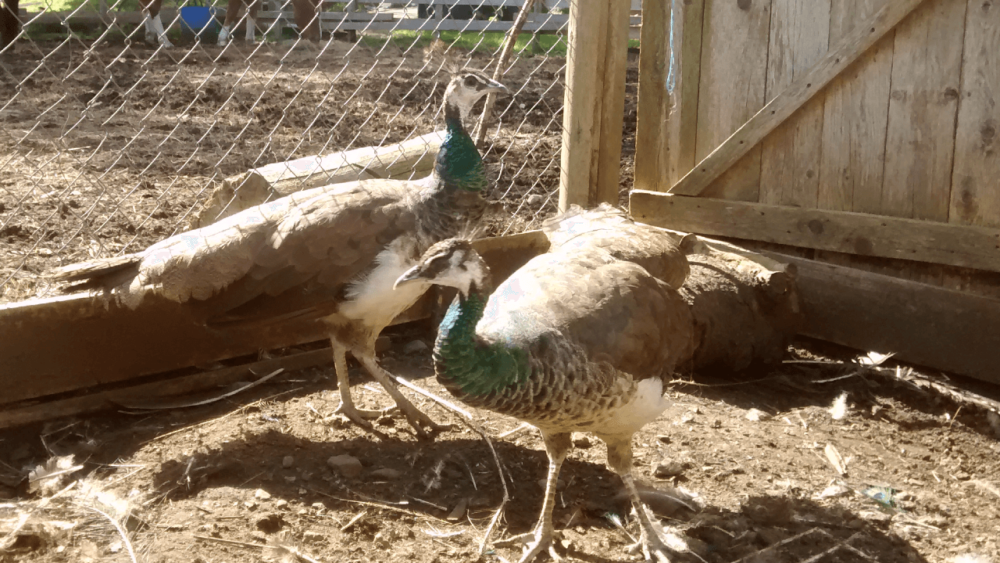
Can I keep peafowl with chickens? Don’t keep peafowl with other birds, including chickens! This drastically increases their risk of blackhead disease, which is fatal to peafowl. Additionally, peafowl can be aggressive toward smaller birds. It’s best to separate peafowl and other birds (ducks, guineafowl, turkeys, pheasants, etc.).
How long is the breeding season for peafowl? Breeding season begins in late February and ends in August. However, peacocks do not typically mate with peahens during the early months. This is simply a period for growing their elaborate trains and attracting – or courting – peahens. My peafowl generally begin mating in May, and the peahens lay a clutch one month later in June, followed by another clutch in late July or early August.
How long does a peacock’s tail grow? Peacocks grow trains over six feet in length. Every year it grows longer, which is an easy way to tell a peacock’s age. They drop their beautiful train feathers in August or September, but they return even longer by February.
Conclusion
There’s no doubt that peafowl are among the most beautiful – and rewarding – birds in the world. They also have different purposes on the farm if you’re flexible and creative.
I love peafowl and’ll likely always have at least a pair. I find their inquisitive, intelligent yet independent nature suits me.
Peafowl aren’t everyone’s cup of tea, however. Take time to research and realistically consider whether or not you can care for them. You’ll enjoy them that much more after putting in the initial effort.

